A family member lent me the book Leaning into the Wind: A Memoir by Ray Hawco (2021, DRC Publishing) thinking I would find his aviation stories interesting. And of course I did.
The bulk of the memoir focuses on Hawco growing up in Harbour Main and Argentia, and his various careers as a Catholic priest, a politician, in oil and gas, and as the Newfoundland and Labrador’s chief negotiator for the land claims of the Innu and Inuit peoples of Labrador (which is also interesting to read about a provincial perspective while I’m listening to the audiobook Unsettling Canada: A National Wake-Up Call by Arthur Manuel and Grand Chief Ron Derrickson).
His aviation career, of course, is what is of interest to me, so that’s what I will focus on. In particular, the end of the book is a timeline of incidents and accidents, and I particularly liked, how after incident, he had at “Lessons Learned” comment at the end, which ranged from the need to better inspections to “Sometimes you have to be lucky” which shows some of the wit found throughout the memoir.

From 1969 to 2017, Hawco flew somewhere between 6,500 and 7,000 hours, and had flows a number of aircraft, including Piper Colt, Cherokee 140, Cessna 150 and 180, and Beavers, but most of his flying time was in his own aircraft which were a Champ 7GC which he owned from 1970 to 1975, a Piper Super Cruiser, owned from 1975 to 1987, and a Cessna Skyhawk, owned from 1987 to 2017. Hawco learned to fly in Gander, but was touched by aviation earlier than that while living in Argentia. Of course there were aircraft flying in and out of the US Naval base, which sparked an interest for Hawco.
He had a close call when a B-26 passed near their house before it crashed. Hawco shares some interesting details. He was at home, in the living room, doing his homework when he saw the fireball that was the aircraft. It looked as if it was going straight for their house, but passed by and crashed. His home, as well as the others in the area, were evacuated, particularly because there was fuel and oil lines near where the plane crashed. Of course, being a curious youth, he and a friend snuck away from the evacuation site and hid under a platform at one of the warehouses only a hundred or so feet from the crash and watched the rescue/retrieval operation. He only moved when they heard the fire chief say the oil lines passed near where they were hiding, and so they crept away.
The wreckage was partially submerged, and what wasn’t was burning. The aircraft was later recovered from the water. I found an article from The Evening Telegram about the incident:

Hawco, in his flying career, had dealings with many other folks who were heavily involved in aviation in Newfoundland and Labrador, such as Royal Cooper, who flew Hawco’s aircraft back to Gander after a crash, and Bill Bennett of Gander Aviation, with whom Hawco flew many times. Hawco flew back and forth from his parish in Bonavista to St. John’s and Gander as part of his involvement with different organizations. At first, he did get in some trouble from his superiors in the church for having an aircraft, but it was decided that it was not an issue. Again, his ownership of an aircraft gave some issue when he was assigned to the parish in Buchans, but much of that was that the mine in Buchans did not want him to use their dock nor their fuel for his aircraft. After he left the church and married, he and his wife, Marie, took many flights together, and he later took his children flying, though they never seemed to have the same passion for flight. Hawco also enjoyed taking up the young and the old on their first flights, sometimes letting his older passengers take control for brief periods when they were in the air.
His list of incidents and accidents shows his skill as a pilot, in particular, when he was told he could land on the Saint John River in Fredericton. The river was choppy, and at first Hawco wasn’t going to be given permission to land, until Tom Vickers who was flying a RCMP helicopter near Hawco, said “anyone who can land a plane of La Scie in the month of November should have no trouble landing here.” Sure enough, Hawco landed, though he did get muddy and wet walking to Sutherland’s Garage where he was going to pick up his new Cessna, call number CF-QKD. And as with any Newfoundland pilot, Hawco had his run ins with heavy fog (especially unexpected heavy fog) and had a few episodes where Search and Rescue had to be called, though he often made his way to safety before having to be rescued.

I also found a short CBC article where Hawco is interviewed. Hawco, in his later years, often flew out of Paddy’s Pond and seemed to know many of the other flyers in the area. This article is about the crash of another pilot at Paddy’s Pond.

Overall, this was an interesting book with some great stories about flying around Newfoundland, sometimes even with his pets!







